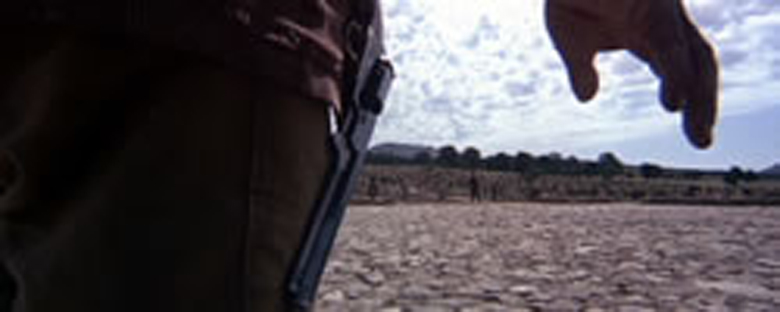Reviews
Il Buono, il brutto, il cattivo
Sergio Leone
Italy, 1966
Credits
Review by Rumsey Taylor
Posted on 11 July 2004
Source MGM Special Edition DVD (restored Italian cut)
There are many features that contribute to The Good, the Bad and the Ugly’s belated renown, and none as idiosyncratic as Ennio Morricone’s score. The film’s aural trademark is a coyote’s squall, incarnated in variations in the principal theme: vocal harmonization, whistling, and a woodwind instrument. Unaccompanied, this sound is bizarre (try singing it out loud), and but one component of Morricone’s unorthodox orchestration, which includes a galloping snare drum and an electric guitar.
Despite its oddity, Morricone’s score is an intrinsic component of Sergio Leone’s film. Cleverly, the first sound in the film (which occurs after an animated title credits sequence, scored in Morricone’s overture) is a coyote’s howl (this occurs off screen, somewhere in the distance of the opening shot), which fuses the film’s ardent visual and aural elements. Ironically, Morricone’s crudely unusual score is the most distinctive feature of this film, in which most every other sound is noticeably out-of-sync.
The Good, the Bad and the Ugly is a stark thematic and stylistic contrast to the westerns that populated prior decades. Leone favors caricatures, and resists the mythological characterizations that typify the work of John Ford. In chronology, Leone’s westerns denote a transition, and clearly presage the emphasis upon style and violence that characterize Sam Peckinpah’s The Wild Bunch. In keeping with this chronology, The Good, the Bad, and the Ugly is peripherally concerned with the Civil War, or, a loss of American heritage. Like Peckinpah’s, Leone’s film identifies this loss recurrently and includes references to technology. One of the film’s ordinate shootouts is interrupted by the blasts of off-screen cannons.
Leone was charged with replicating Akira Kurosawa in his first spaghetti western (A Fistful of Dollars, which emulated Yojimbo). Kurosawa’s influence in this film is apparent, although less distinct. While both directors use deeply focused compositions, Leone’s employment of this optical technique is not to compound action (as with Kurosawa, who was initially more confined within a 1.33:1 frame ratio) but to transpose it. His stylistic signature is a sustained close-up portrait of a weathered, aged human face. There is a polarized contrast between these dominant close-ups and distant master shots, and this contrast is often made in a single shot. Despite this tactic in transposing fore- and backgrounds, each of these portraits and landscapes are similarly detailed.
Leone’s men are characterized by physical imperfection, greedy like villains, with scars and vocal impediments. In the final scene Angel Eyes (the Bad) holds a poised hand above his holster, and the shot lasts long enough for the viewer to notice that he’s missing part of his middle finger. Every face in this film is laden with soot and chapped by a constant sun. There is effort to realize these characters” physical characteristics (the costumes and setting are the product of Leone’s meticulous research), yet this is an embellished film in its dialogue and staging. Clint Eastwood’s (The Good) dialogue, although sparing, is routinely witty, humorous, and confident, which he maintains even after a torturous walk, as a hostage, through a desert. Moreover, every character with a gun has supernatural aim; duels are won by the quicker draw. Reinforcing Leone’s preference for caricatures, Eastwood is rarely seen without a handmade cigar. At one point in the film, he is tracked by Tuco (the Ugly). His search is not difficult, as he follows the trail of recently extinguished cigars.
In Leone’s previous entries in “The Man With No Name” trilogy, the director was credited with an American pseudonym, Bob Robertson, in an effort to market the genre to its parent country. This is misleading, as it serves to imply a domesticity. Leone’s trilogy is, however, literally and stylistically foreign. It is not characterized by its shootouts and plotting (although the resolution of this film is somewhat expected, its progression is unpredictable) inasmuch as it is by its style. There are sequences in the film without dialogue that seem unnecessarily patient (despite a shared interest in violence, Peckinpah ignores Leone’s influence in pacing). In all, The Good, the Bad, and the Ugly is more contemporary than the sort of films that spawn it, and is more appropriately akin to the resurgence of crime films in the following decade. After having declined an option to direct The Godfather, Leone would further propagate the crime genre with his final film.
We don’t do comments anymore, but you may contact us here or find us on Twitter or Facebook.



